Homo erectus
Online Biology Dictionary
|
|
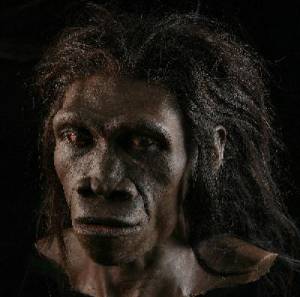
|
|
A reconstruction of a Homo erectus female (based on fossil ER 3733) by paleoartist John Gurche, part of the Smithsonian National Museum of Natural History’s Human Origins Program. Credit: Smithsonian National Museum of Natural History’s Human Origins Program. |
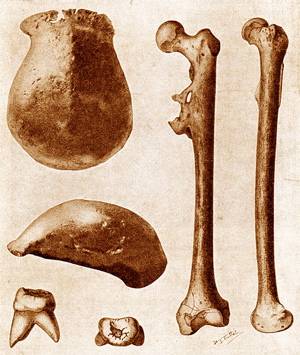
|
|
Homo erectus: Original specimens found at Trinil |

|
|
Workers at Trinil |
|
|
|
Eugene Dubois |
|
|
Inspired by Darwin's new theory of evolution, Dutch anatomist Eugene Dubois set out to find the remains of an early human. In 1891, after a five-year search, he succeeded. On the island of Java, at Trinil, on the banks of the Solo River, he found the partial remains of a very ancient human being.
Dubois named his find Pithecanthropus erectus (later the generic name Pithecanthropus was changed to Homo to reflect the great similarity of this hominid to modern humans). But the public soon dubbed this hominid "Java Man."
The specimens (see picture at right) — a skullcap, a femur, and a molar — were the first of Homo erectus ever found and the first of any hominid differing from modern humans discovered outside Africa or Europe. Dubois was convinced that he had found the missing link between apes and human beings (thus the name Pithecanthropus, which means "ape-man").
On the way back to Europe with his treasured bones, Dubois and his family faced a storm at sea. Racing to the hold, Dubois told his wife "If anything happens, I've got to take care of my specimens! You see to the children!"
Homo erectus in China
After Dubois, beginning in the 1920s, the story of the discovery of Homo erectus shifts to China. There, international research teams found numerous H. erectus specimens at Zhoukoudian ("Hill of the Dragons"), near Beijing. This putatively new early human was soon dubbed "Peking man" (Beijing was then called Peking).
The first remains found, two fossil teeth, were obtained by a Swedish team headed by Otto Zdansky, a young Austrian paleontologist. On the basis of this scanty evidence, Canadian anatomist Davidson Black (1926) created the new genus Sinanthropus ("man from China"). Black also managed to persuade the Rockefeller Foundation to fund a large scale excavation project at Zhoukoudian.
In the ensuing years, a few more jaws and teeth were turned up by the Swedish team, now headed by Birger Bohlin, a paleontologist specializing in fossil giraffes. Then, in December 1929 a young member of Black's team, Pei Wenzhong (1904–1982) found the first skull. By 1936, the year that excavation at Zhoukoudian ceased due to the Japanese invasion of China, a total of 14 skulls, 11 jawbones and 147 teeth had been discovered. The material was obviously similar to Dubois' Pithecanthropus erectus (both Dubois' material and that obtained at Zhoukoudian have since been assigned to Homo erectus).
The foramen magnums of the skulls from Zhoukoudian had been artificially enlarged and no postcranial material was found. These facts resulted in speculation that the recovered remains were the product of cannibalism. But this has never been established with certainty.
Black died of a heart attack in 1934, and Franz Weidenreich, a German anatomist and anthropologist, inherited the project and it was he who wrote up and published the detailed descriptions of the material. Most of the Zhoukoudian fossils were lost in shipment during World War II, though casts of the original fossil material have been preserved.
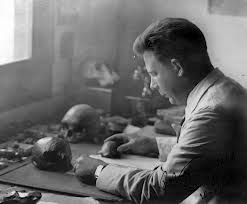
|
| G. H. R. von Koenigswal |
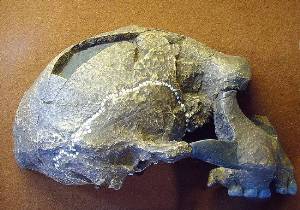
|
| Homo erectus – Sangiran (Enlarged view) Photo: Wikimedia |
During the thirties, the material from China, now attributed to H. erectus, was assigned to the genus Sinanthropus, while Javan fossils were assigned to Pithecanthropus. However, in 1939, paleoanthropologist G. H. R. von Koenigswald, who in the thirties had resumed Dubois' hunt for hominids in Java, took some of specimens he had found (at Sangiran in the Solo Valley) to Weidenreich in Beijing. They soon saw that the remains from Java and Zhoukoudian were quite similar. They decided to abandon the genus Sinanthropus and to place all the specimens in Pithecanthropus. Still later, Ernst Mayr (1950) assigned Pithecanthropus to the genus Homo as Homo erectus, where it has remained.
Homo erectus: In or out of Africa?
Darwin had predicted human origins would be traced to Africa. However, for a time after the discoveries on Java and at Zhoukoudian it was believed that humans had had Asian origins. Fossils assigned to H. erectus are indeed ancient, dating from 400,000 to 2,000,000 years in age. But other even more ancient fossils, in particular the discovery of very early hominids (australopithecines) in Africa by Raymond Dart, Robert Broom, and the Leakeys led to a shift in opinion back to Africa.
Currently, there are two unresolved hypotheses concerning Homo erectus: (1) Specimens assigned to Homo ergaster should be assigned to erectus, which would then be the direct ancestor of later hominids such as Homo heidelbergensis, Homo neanderthalensis, and Homo sapiens; or, alternatively, (2) erectus may be an Asian form distinct from African ergaster.
Whichever of these views is correct, Homo erectus is the earliest hominid known outside of Africa, and was perhaps also the first to use fire. The remains of early humans of this type are generally found in association with Acheulean tools, which represented a step of sophistication above the Oldowan, or "pebble tool" technology characteristic of earlier hominids.
Homo erectus had an average cranial capacity of about 1000 cc (range: 850–1100 cc) — significantly larger than that of earlier hominids. In fact, in brain size certain Homo erectus individuals exceeded many modern humans of normal intelligence. For example, the brain of the Noble Prize winning novelist Anatole France (1844–1924) had a volume of only 1000 cc. This is not, of course, to say that the brains of modern humans are not larger on average — in fact, another writer, Jonathan Swift had a cranial capacity of 2000 cc.
Perhaps we are not from the apes alone?
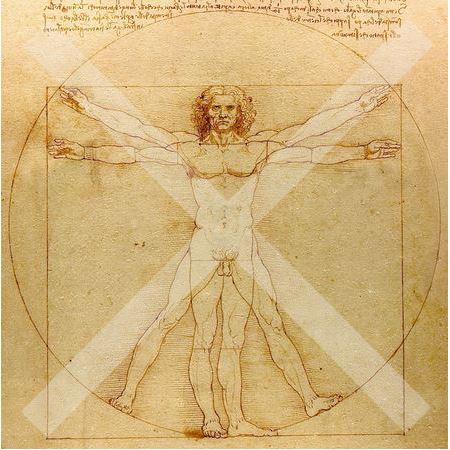
|
|
Diet: Omnivorous.
Synonyms: Etymology: The Latin word homo means "man" or "human being" and Latin erectus means upright or erect. The original scientific name of this hominid, given it by Dubois, was Pithecanthropus erectus, meaning upright man-ape. Pronunciation: /HŌM-ō ə-REK-təs/. Note: It has often been suggested that Homo habilis was the immediate ancestor of H. erectus. However, a recent research (Spoor et al. 2007) indicates the two coexisted for at least half a million years. |
Interesting facts about other members of genus Homo:
Australopithecus bahrelghazali >>
Most shared on Macroevolution.net:
Human Origins: Are we hybrids?
On the Origins of New Forms of Life
Mammalian Hybrids
Cat-rabbit Hybrids: Fact or fiction?
Famous Biologists
Dog-cow Hybrids
Georges Cuvier: A Biography
Prothero: A Rebuttal
Branches of Biology
Dog-fox Hybrids